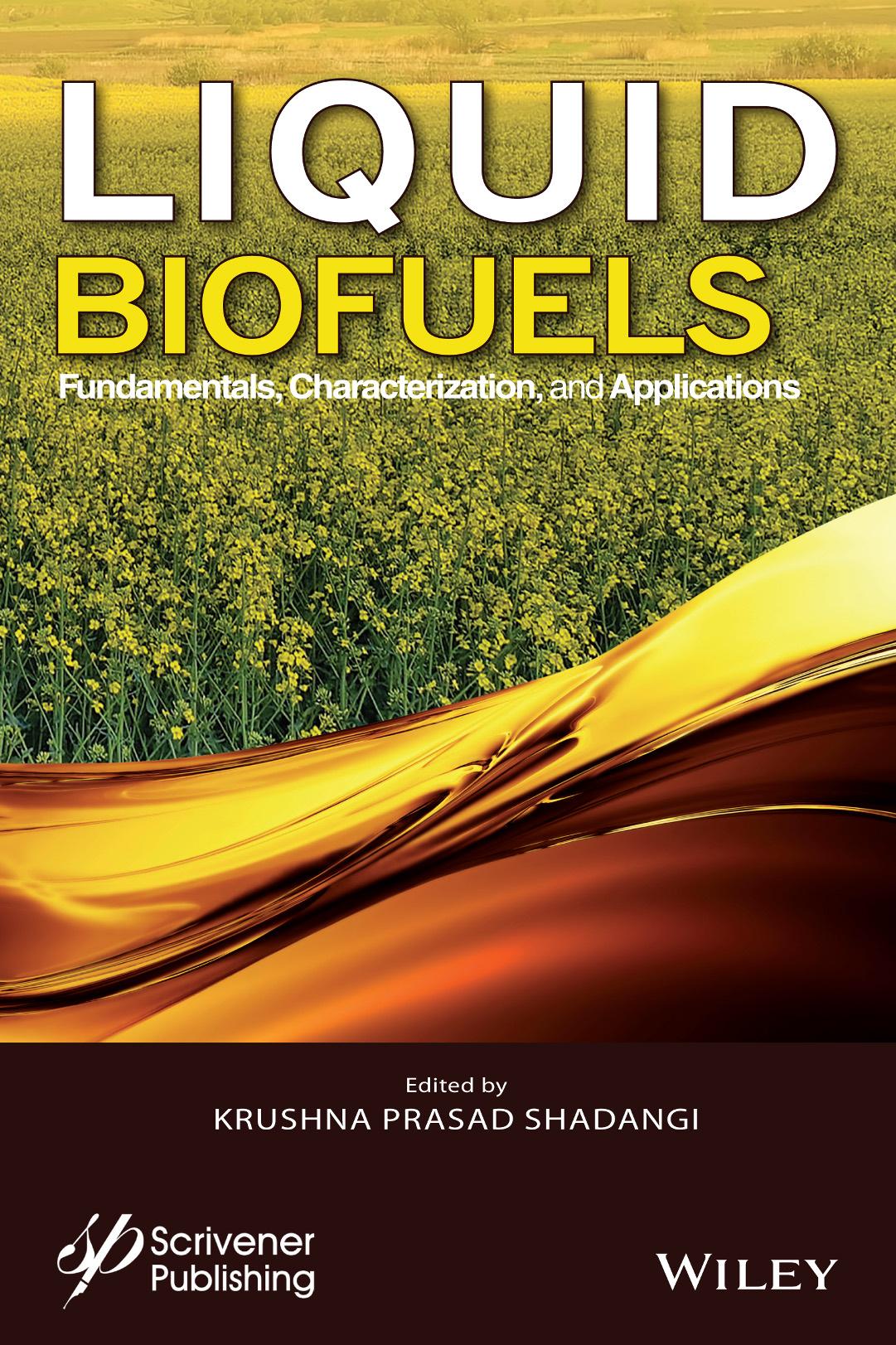https://ebookmass.com/product/liquid-biofuels-fundamentals-
Instant digital products (PDF, ePub, MOBI) ready for you
Download now and discover formats that fit your needs...
Reservoir Characterization: Fundamentals and Applications. Volume 2 Fred Aminzadeh
https://ebookmass.com/product/reservoir-characterization-fundamentalsand-applications-volume-2-fred-aminzadeh/
ebookmass.com
Biofuel Extraction Techniques: Biofuels, Solar, and Other Technologies Lalit Prasad
https://ebookmass.com/product/biofuel-extraction-techniques-biofuelssolar-and-other-technologies-lalit-prasad/
ebookmass.com
Liquid-Liquid and Solid-Liquid Extractors 1st Edition Jean-Paul Duroudier
https://ebookmass.com/product/liquid-liquid-and-solid-liquidextractors-1st-edition-jean-paul-duroudier/
ebookmass.com
The Duchess Takes a Lover Jillian Eaton
https://ebookmass.com/product/the-duchess-takes-a-lover-jillian-eaton/
ebookmass.com
Premodern Rulers and Postmodern Viewers : Gender, Sex, and Power in Popular Culture 1st Edition
Janice North
https://ebookmass.com/product/premodern-rulers-and-postmodern-viewersgender-sex-and-power-in-popular-culture-1st-edition-janice-north/
ebookmass.com
Marcel Proust Michael Wood
https://ebookmass.com/product/marcel-proust-michael-wood/
ebookmass.com
Ancient Women Writers of Greece and Rome Bartolo Natoli
https://ebookmass.com/product/ancient-women-writers-of-greece-androme-bartolo-natoli/
ebookmass.com
Tropical Forests in Prehistory, History, and Modernity
Patrick Roberts
https://ebookmass.com/product/tropical-forests-in-prehistory-historyand-modernity-patrick-roberts/
ebookmass.com
Reshaping Confucianism: A Progressive Inquiry Chenyang Li
https://ebookmass.com/product/reshaping-confucianism-a-progressiveinquiry-chenyang-li/
ebookmass.com
Chemistry for the IB Diploma Programme (Higher level) 3rd
https://ebookmass.com/product/chemistry-for-the-ib-diploma-programmehigher-level-3rd-edition-brown/
ebookmass.com
Liquid Biofuels
Fundamentals, Characterization, and Applications
Edited by Krushna Prasad Shadangi
This edition first published 2021 by John Wiley & Sons, Inc., 111 River Street, Hoboken, NJ 07030, USA and Scrivener Publishing LLC, 100 Cummings Center, Suite 541J, Beverly, MA 01915, USA © 2021 Scrivener Publishing LLC
For more information about Scrivener publications please visit www.scrivenerpublishing.com.
All rights reserved. No part of this publication may be reproduced, stored in a retrieval system, or transmitted, in any form or by any means, electronic, mechanical, photocopying, recording, or otherwise, except as permitted by law. Advice on how to obtain permission to reuse material from this title is available at http://www.wiley.com/go/permissions.
Wiley Global Headquarters
111 River Street, Hoboken, NJ 07030, USA
For details of our global editorial offices, customer services, and more information about Wiley products visit us at www.wiley.com.
Limit of Liability/Disclaimer of Warranty
While the publisher and authors have used their best efforts in preparing this work, they make no representations or warranties with respect to the accuracy or completeness of the contents of this work and specifically disclaim all warranties, including without limitation any implied warranties of merchantability or fitness for a particular purpose. No warranty may be created or extended by sales representatives, written sales materials, or promotional statements for this work. The fact that an organization, website, or product is referred to in this work as a citation and/or potential source of further information does not mean that the publisher and authors endorse the information or services the organization, website, or product may provide or recommendations it may make. This work is sold with the understanding that the publisher is not engaged in rendering professional services. The advice and strategies contained herein may not be suitable for your situation. You should consult with a specialist where appropriate. Neither the publisher nor authors shall be liable for any loss of profit or any other commercial damages, including but not limited to special, incidental, consequential, or other damages. Further, readers should be aware that websites listed in this work may have changed or disappeared between when this work was written and when it is read.
Library of Congress Cataloging-in-Publication Data
ISBN 978-1-119-79198-0
Cover image: Oil Wave - Zoya Fedorova | Dreamstime.com Biofuel Field - Sergey Sopko | Dreamstime.com
Cover design by Kris Hackerott
Set in size of 11pt and Minion Pro by Manila Typesetting Company, Makati, Philippines
USA
2
S. Malani, Vijayanand S. Moholkar, Nimir O. Elbashir and Hanif A. Choudhury
2.3
4.4
3.2.3
5
5.3
Martínez-Narro
5.3.1
5.3.2
5.3.3
6.1
6.2
6.6
6.5.1
6.5.2
6.5.3
6.5.4
6.5.5
6.5.6
6.6.1
6.6.2
6.6.5
6.6.6
6.6.7
6.6.8
6.7
Soumya Sasmal and Kaustubha Mohanty
7.6.3
8.4.4
8.4.5
8.4.6
8.5.4
9.2.2
9.3.5.1
10
Vikranth Volli, Randeep Singh, Krushna Prasad Shadangi and Chi-Min Shu
Abhishek Walia, Chayanika Putatunda, Preeti Solanki, Shruti Pathania and Ravi Kant
11.3.3.4
13.5.3 Organosolvent Pretreatment
14 Application of Nanotechnology in the Production of Biofuel
Trinath Biswal and Krushna Prasad Shadangi
14.1 Introduction
14.2 Various Nanoparticles Used for Production of Biofuel
14.2.1 Magnetic Nanoparticles
14.2.2 Carbon Nanotubes (CNTs)
14.2.3 Graphene and Graphene Derived Nanomaterial for Biofuel
14.2.4 Other Nanoparticles Applied in Heterogeneous Catalysis for Biofuel Production 495
14.3 Factors Affecting the Performance of Nanoparticles in the Manufacturing Process of Biofuel 495
14.3.1 Nanoparticle Synthesis Temperature 496
14.3.2 Pressure During Synthesis of Nanoparticle 496
14.3.3 pH Influencing Synthesis of Nanoparticles 496
14.3.4 Size of Nanoparticles 496
14.4 Role of Nanomaterials in the Synthesis of Biofuels 496
14.5 Utilization of Nanomaterials for the Production of Biofuel 497
14.5.1 Production of Biodiesel Using Nanocatalysts 497
14.5.2 Application of Nanomaterials for the Pretreatment of Lignocellulosic Biomass 500
14.5.3 Application of Nanomaterials in Synthesis of Cellulase and Stability 501
14.5.4 Application of Nano-Materials in the Hydrolysis of Lignocellulosic Biomass 501
14.5.5 Bio-Ethanol Production by Using Nanotechnology 502
14.5.6 Application of Nanotechnology in the Production of Bio-Ethanol or Cellulosic Ethanol 506
14.5.7 Up-Gradation of Biofuel by Using Nanotechnology 508
14.5.8 Use of Nanoparticles in Biorefinery 509
14.6 Conclusion 510 References 511
15 Experimental Investigation of Long Run Viability of Engine Oil Properties in DI Diesel Engine Fuelled with Diesel, Bioethanol and Biodiesel Blend
Dulari Hansdah and S. Murugan
15.1 Introduction
15.2
15.3
15.4
15.2.1
15.3.1
15.3.2
15.4.1
15.4.2
15.4.2.1
15.4.3
15.4.3.1
15.4.3.2 Analysis
16 Studies on the Diesel Blends Oxidative Stability in Mixture with TBHQ Antioxidant and Soft Computation Approach Using
16.3
16.2.5
16.2.6
16.2.7
16.2.8
16.3.1
16.3.9 Performance and Emission Characteristics of CIB Diesel Blends + TBHQ
16.4 Response Surface Methodology for Performance Parameter
16.4.1 Non-Linear Regression Model for Performance Parameter
16.4.2
16.4.4 Response Surface Plot and Contour Plot for BSFC 571
16.4.5 Response Surface Plot and Contour Plot for BTE 576
16.4.6 Non-Linear Regression Model for Emission Parameter
16.4.8 ANOVA for Emission Parameters
16.4.9 Response Surface Plot and Contour Plot for CO 586
16.4.10 Response Surface Plot and Contour Plot for HC 591
16.4.11 Response Surface Plot and Contour Plot for NOx 591
16.4.12 Response Surface Plot and Contour Plot for CO2 592
16.5 Modelling of ANN 593
16.5.1 Prediction of Performance Characteristics 596
16.5.2 Prediction of Emission Characteristics 597
16.6 Validation of RSM and ANN 599
16.7 Conclusion 606 References 608
17
V.Dhana Raju, S.Rami Reddy, Harish Venu, Lingesan Subramani and Manzoore Elahi M. Soudagar
18
Sakthivel R, Mohanraj T, Abbhijith H and Ganesh Kumar P
18.6
K. Adithya, C.M Jagadesh Kumar, C.G. Mohan, R. Prakash and N. Gunasekar
Preface
The goal of this book is to provide a profound contribution to the research about liquid biofuel technologies from fundamental to applications for engineers and scientists.
This book is an advanced assemblage of twenty chapters including “Introduction to Biomass to Biofuels Technologies”, “Advancements of Cavitation Technology in Biodiesel Production – from Fundamental Concept to Commercial Scale-up”, “Heterogeneous Catalyst for Pyrolysis and Biodiesel Production”, “Algal biofuel: Emergent applications in next generation Biofuel Technology”, “Co-liquefaction of Biomass to Biofuels”, “Biomass to Bio Jet Fuels: A Take Off to the Aviation Industry”, “Advance in Bio-ethanol Technology: Production and Characterization”, “Effect of Process Parameters on the Production of Pyrolytic Products from Biomass Through Pyrolysis”, “Thermo-Catalytic Conversion of Non-Edible Seeds (Extractive-Rich Biomass) to Fuel Oil”, “Suitability of Oil Seed Residues as a Potential Source of Bio-Fuels and Bioenergy”, “Co-Conversion of Algal Biomass to Biofuel”, “Pyrolysis of Caryota Urens Seeds: Fuel Properties and Compositional Analysis”, “Bio-Butanol as Biofuels: The Present and Future Scope”, “Application of Nanotechnology in the Production of Biofuel”, “Experimental Investigation of Long Run Viability of Engine Oil Properties in DI Diesel Engine Fuelled with Diesel, Bioethanol and Biodiesel Blend”, “Studies on the Diesel Blends Oxidative Stability in Mixture with TBHQ Antioxidant and Soft Computation Approach Using ANN and RSM at Varying Blend Ratio”, “Effect of Nanoparticles in Bio-Oil on the Performance, Combustion and Emission Characteristics of a Diesel Engine”, “Use of Optimization Techniques to Study the Engine Performance and Emission Analysis of Diesel Engine”, “Engine Performance and Emission Analysis of Biodiesel-Diesel and Biomass Pyrolytic Oil-Diesel Blended Oil: A Comparative Study”, and “Agro-Waste for Second-Generation Biofuels”.
I take the prospect to express my honest thanks to all the proficient authors from India, Turkey, Qatar, United Kingdom, and Taiwan who have imparted their enthusiastic efforts in contributing such beautiful and very
xxii Preface
informative chapters with the most recent literature and case studies on fundamentals and applications of liquid biofuels.
Copious support and encouragement from my parents, elder brother, sister-in-law, and my sweet wife has provided me the confidence and strength to technically manage and complete this book.
I also thank Wiley-Scrivener for the cooperation in developing this comprehensive book.
Dr. Krushna Prasad Shadangi
Assistant Professor Department of Chemical Engineering
Veer Surendra Sai University of Technology, Burla, Sambalpur, Odisha, India
Introduction to Biomass to Biofuels Technologies
Ezgi Rojda Taymaz, Mehmet Emin Uslu and Irem Deniz*
Bioengineering
Department, Faculty of Engineering, Manisa Celal Bayar
University, Muradiye-Manisa, Turkey
Abstract
Biofuels are renewable, environmentally friendly, alternative fuels suitable for use as heat, power and alternative engine fuel, important for the socioeconomic development of countries, resource diversity and supply security. Applications of liquid-solid-gas biofuels obtained from biomass in energy sources are increasing rapidly. The bioenergy sector has a rather complex structure due to the diversity of potential raw materials and technical ways to convert biomass into energy. Sixty percent of the biomass is derived from agricultural waste, and various conversion techniques are applied to these organic wastes for bioenergy production. The most important alternative biofuels based on biomass can be classified as bioethanol, biodiesel, biogas, bio-methanol, bio-methyl ether and bio-oil. The most common biofuels are bioethanol and biodiesel. Biofuels have been found to increase its usability due to being based on renewable biological resources and non-toxic, having a good biodegradability, causing very low emissions when burned and being environmentally friendly. This chapter investigates biomass resources and biofuel technologies in a bio-refinery concept.
Keywords: Biomass, biofuel, bio-refinery, conversion techniques, energy, liquid biofuels
1.1 Introduction
Non-fossil biomass can be used for bioenergy production. This bioenergy is called biomass energy and is defined as the conversion of energy from
*Corresponding author: iremdenz@gmail.com
Krushna Prasad Shadangi (ed.) Liquid Biofuels: Fundamentals, Characterization, and Applications, (1–38) © 2021 Scrivener Publishing LLC
the sun by plants. Its principle is to use the energy stored in the plant in its transformed form when needed. Biomass energy is examined in two groups as classical and modern. Classical biomass energy consists of firewood, plant and animal residues obtained from conventional forests. The main character of the use of classical biomass energy is that the energy from the biomass material is obtained through various combustion tools and direct combustion techniques from primitive to developed ones. Modern biomass resources are listed as energy forestry products, forest and wood industry wastes, energy agriculture, vegetable and animal wastes in the agricultural sector, urban wastes, and agriculture-based industrial wastes [1].
Biomass materials are transformed into biofuels after pre-preparation and conversion. Biofuels can be used for heat and electricity production. Biofuel use ranges from large central power station to vehicles. Modern biomass energy techniques are based on transforming the material so that the physical condition remains constant and/or changed. Biomass is divided into low biomass techniques and high biomass techniques. Low biomass techniques are direct combustion, anaerobic decomposition, fermentation-distillation processes. High biomass techniques consist of pyrolysis, hydrogasification, acid hydrolysis, and biological hydrogen production processes. Modern biomass energy is a sustainable energy source, in full compliance with the environment. Biofuels are the general names of gas, liquid and solid products obtained by passing agricultural products, wood, animal, plant and urban waste through various biochemical and/or thermochemical conversion processes. Gas biofuels; bio-hydrogen, biogas, synthetic gases, solid biofuels; wood coal, bio-char, bio-pellet, bio-bricket, liquid biofuels; bioethanol, biodiesel, bio-methanol, bio-methyletheter and vegetable oils [1, 2].
It is possible to produce both energy and new chemicals using different methods from biomass. Biogas and ethanol can be produced by fermentation in anaerobic environment [3]. Gas fuel and activated carbon are produced by pyrolysis from wastes with a high percentage of solid with thermal decomposition. Synthetic fuel (syngas) production can be made by hydrogasification and hydrogenation. Heat energy and electricity are produced by burning garbage and solid wastes directly with air. Organic fertilizer is produced as a result of composting of garbage and animal feces [1].
1.2 Lignocellulosic Biomass and Its Composition
Various agricultural by-products and vegetal wastes that are released to the environment as solid wastes can be considered as biomass sources. Such substances show similarities with wood in terms of their general













